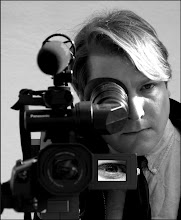LUND--I must confess to a certain distaste for making movies, which may go hand in hand with my certain distaste for the digital world. The thing is, if you asked any photographer 100 years ago, if he wanted what digital can offer he would have run over his sainted grandmother to get a Nikon D1 (2,3) x. Go ahead, raise Matthew Brady from the grave and see if he would turn down unlimited photos of high quality in a compact package with lenses from the extreme wide angle to the extreme telephoto, and in color no less. Nah, he would have turned you down flat and said, "No, I stand by the artistic integrity of black and white wet plates and the need to carry a darkroom on a wagon around with me." Yeah, I'm sure that's what he would have said. When is the last time anyone had to consider hay as a necessary photographic accessory?
But I do see, when I film, that I sometimes jerk the camera because I am trying ever so slightly to reach with me eyes for my still camera. I often think of the potentially great photos I am missing because I am filming. I think I would feel that pain less if I knew I was running costly film through my Bolex instead of almost limitless miniDV tape through my Panasonic. But I do remember I wanted to make film since I was a kid. Just that those dreams were put aside because of the cost whereas I have had a Nikon FM since I was 12. I had a whole WW!! movie plotted out and even filmed the first few scenes with an old hand-wind 8mm camera. It was called "Code Word to Rome" and, perhaps luckily, I have no idea what happened to the footage. As a senior in High School we studied Eric Marie Remarque's "All Quiet on the Western Front". One of the guys in my group had a surgeon father who was an amateur video enthusiast with some early home video editing equipment. We made a short movie of Remarque's book. I remember it as being pretty good, all things considered.
But now I am making films and it is amazing that if you are crazy enough to do it you can find the money, now, for the equipment that not so long ago would have cost one, well, so much that I was perfectly happy toting my already expensive still rig around the world.
Maybe I would feel less ambivalence if I had someone to help me carry everything...





